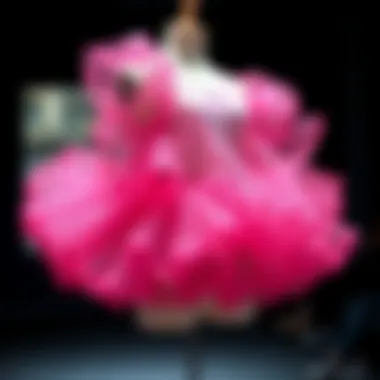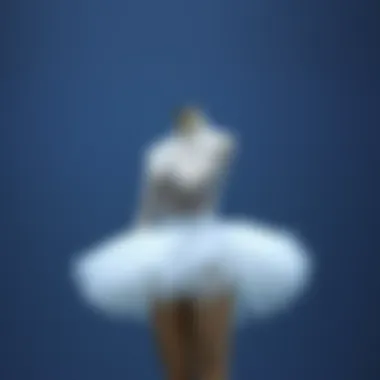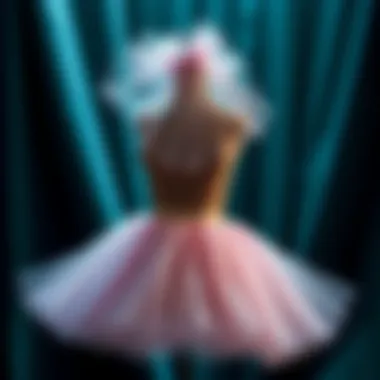Exploring the Role of Netting Fabric in Tutus


Intro
Tutu construction has been an art form that has stood the test of time. At the heart of this fascinating craft lies netting fabric, a material that brings both structural integrity and whimsical aesthetics to the dancewear staple. From ballet performances to fashion runways, understanding the nuances of netting can be the difference between a basic tutu and a show-stopping piece.
Netting fabric, with its variety in texture and opacity, offers a unique blend of style and functionality. Designers and crafters alike can leverage its qualities to elevate their creations, making it a critical consideration in tutu construction.
This article explores how netting fabric can be harnessed in various tutu designs, shedding light on its types, characteristics, and applications. Whether you're a seasoned designer or a budding enthusiast, the insights shared here will guide you in making informed choices about netting fabric and refine your constructiton skills.
Fashion Trends
Current Styles and Influences
The world of fashion is constantly evolving, and tutus are no exception. In recent years, we have seen a resurgence of interest in tutu styles, influenced by street wear and high fashion. Designers are now blending traditional ballet aesthetics with modern silhouettes, creating innovative hybrid pieces that are as eye-catching as they are functional.
Contemporary fabrics, along with netting, are often layered and manipulated to produce visual drama, adding dimension to the classic tutu shape. For instance, pairing stiff netting with soft, flowing materials can achieve a stunning textural contrast that appeals to both performers and fashion aficionados.
One noteworthy trend is the asymmetrical tutu, where netting is used to create irregular shapes and layers, evoking a sense of movement that captures the essence of dance. In this context, netting allows designers the flexibility to experiment without losing the integrity of the design.
Forecasting Future Trends
Looking ahead, the fusion of technology and fashion may redefine how netting fabric is utilized in tutu construction. Innovations such as 3D printing and smart textiles offer exciting possibilities for designers aiming to push boundaries. Imagine tutus that change color with body temperature, or fabrics that adapt to different lighting environments - the potential is enormous!
As environmental awareness continues to rise, sustainable materials will likely gain traction in the tutu landscape. Designers may opt for recycled or organic netting fabrics, aligning aesthetics with ethics.
"Fashion is about dreaming and making other people dream." — Donatella Versace
Practical Aspects of Netting Fabric
When it comes to constructing tutus, the selection of netting fabric is paramount. Let's break down some critical points to consider:
- Material Types: Different types of netting can yield varied effects. Some options include tulle, organza, and nylon netting, each offering unique characteristics such as stiffness or drape.
- Density and Opacity: Choosing between sheer or opaque netting will heavily influence the final look. Sheer fabrics provide an ethereal quality, while denser materials enhance structure.
- Color Options: Netting comes in a vast array of colors. This allows for creative layering and blending that can tie a design together seamlessly.
- Durability: Performance and longevity are key. Select netting that can withstand wear and tear, especially for performance pieces.
Epilogue
For further insights into tutu design and the use of netting fabric, feel free to explore additional resources, such as Wikipedia and Britannica. The future of tutu fashion is bright, and netting fabric plays an indispensable role in shaping its narrative.
Understanding Netting Fabric
Netting fabric plays a critical role in the world of tutu construction, serving not just as a base material but also as a canvas on which creativity can flourish. The ability to manipulate and combine various types of netting enables designers to create tutus that are not only functional but also visually striking. As one navigates through the intricacies of tutu design, an understanding of netting fabric becomes paramount for achieving desired silhouettes and structural integrity.
The significance of selecting the right type of netting fabric cannot be overstated. Each type possesses unique characteristics that contribute differently to the final product. When you grasp the nuances of these fabrics, it’s easier to make informed choices that enhance the overall design and usability of the tutu. Designers should take into consideration the characteristics, weight, drape, and maintenance of netting fabrics during the selection process. A strong foundation in this area provides a strong foundation for successful tutu making, allowing for a blend of style, comfort, and durability.
Definition and Characteristics
Netting fabric refers to a type of textile known for its open weave structure, often used in dance costumes, craft projects, and more. Primarily, it is lightweight and allows for breathability while offering a degree of stiffness that is essential in constructing tutus. The defining feature is its airy quality, allowing movement and flow which is essential for dancing. Those intricate patterns and weaves lend not only to artistic expression but also to practical applications in performance wear.
These fabrics come in a variety of colors and textures, empowering creators to inject individuality into their designs. Moreover, netting fabric is generally easy to sew and manipulate, making it a favorite among those working in tutu construction.


Common Types of Netting Fabric
- Soft Tulle: Soft Tulle is perhaps the most commonly associated netting fabric with tutus. It boasts a delicate and refined texture, making it a popular choice among designers. Its key characteristic lies in its softness, draping elegantly to create graceful lines and movement when worn. Ideal for a velvety touch, this fabric also possesses a subtle sheen that adds a layer of sophistication to the tutu. One notable feature of Soft Tulle is its ability to hold its shape without being overly rigid, striking a balance between comfort and support. However, it can be tricky to work with, as its fine threads can snag easily.
- Crinoline: Crinoline sets itself apart through its sturdiness and structure. Made from a stiffer material, Crinoline is often used to create the fullness and volume that many tutu styles demand. Its main characteristic is its ability to stand out, creating a dramatic effect that commands attention. Because it's thicker and less flexible, it provides ample support for layers, allowing a tutu to maintain a bold silhouette. However, its rigidity might not suit designs requiring a more fluid look, making its use dependent on the specific style goals of the designer.
- Organza: This fabric captivates with its crisp texture and slight sheen. Known for its lightweight properties, Organza makes for a great addition to any tutu design, adding an element of glamour. Its key characteristic is its strength paired with transparency; this allows layers to build up beautifully without overwhelming the entire look. A unique feature of Organza is its stiffer texture, which can sometimes be a double-edged sword. While it holds shape well, it can also create a somewhat restrictive feel if used excessively. Thus, moderation is key when incorporating it into a tutu.
Differences between Netting Fabrics
Understanding the differences between various netting fabrics can elevate a tutu design from ordinary to extraordinary.
- Transparency Levels: Transparency plays a critical role in the visual impact of the final piece. Fabrics like Soft Tulle offer a delicate, sheer quality that creates ethereal designs, while Crinoline carries a more opaque presence, making it more suitable for foundational layers. The choice of transparency also dictates how other colors and textures interact, allowing for unique visual compositions.
- Texture Variations: The texture affects not only the aesthetic appeal but also the functionality of the tutu. Soft, smooth textures provide a comforting feel against the skin, while rougher textures can create a more structured design. Designers can play with these variations to evoke different moods—whether whimsical or classic—thus allowing the wearer’s personality to shine through.
- Support and Structure: This aspect cannot be overlooked when deciding which netting fabric to employ. Some fabrics, such as Crinoline, inherently provide greater support and structure, ideal for achieving those voluminous looks. Others, like Soft Tulle, lend themselves to a softer, more flowing silhouette. Understanding these dynamics will help designers choose fabrics based on the intended movement and style of the tutu—whether for performance or recreational purposes.
By grasping the essentials of netting fabric—from the unique characteristics of each type to their functional differences—designers can drive their creations forward, capturing both the essence of the tutu and the artistic expression they wish to convey.
The Role of Netting Fabric in Tutu Design
Netting fabric performs a critical role in tutu design, acting as the backbone of this iconic garment. Whether one is crafting a classic ballet tutu or a whimsical costume, the right choice of netting can make all the difference. The unique properties of netting fabric enable it to shape the silhouette, enhance volume, and contribute aesthetic charm. Understanding how netting influences these aspects helps designers ensure their creations are not just visually appealing but also practical.
Enhancing the Silhouette
Netting fabric is pivotal when it comes to sculpting the silhouette of a tutu. The lightweight nature of materials like tulle or crinoline helps maintain a flowing elegance without overwhelming the dancer's movements. With a flick of the wrist or a grand jeté, these fabrics create an ethereal quality, allowing the tutu to seem as if it has a life of its own.
The trick lies in how the fabric is cut and structured; for example, a longer, cascading layer made from soft tulle can create a delicate softness that beautifully contrasts with the sharper lines of crinoline. This interplay of textures is what brings dimension to the overall look and feel of a tutu, making it visually striking and graceful at the same time.
Creating Volume and Structure
Layering Techniques
Layering techniques are essential when it comes to constructing a tutu that stands out. By stacking different types of netting fabrics, one can achieve remarkable levels of volume and drama. For instance, starting with a base of stiffer crinoline followed by softer tulle can add that bounce and flair that ballerinas desire.
This method not only enhances the appearance but also allows for a customizable approach to design. Designers can play with the amount of layers and types of fabric to achieve varying degrees of fullness. What makes layering particularly beneficial is its versatility; it can be tailored to different aesthetics and forms, whether one aims for a vintage look or a modern touch.
Use in Different Tutu Styles
Different tutu styles call for different applications of netting fabric. For example, a classical tutu, often seen in ballet, requires a stiffer construction to maintain its shape. Here, crinoline takes precedence, providing the necessary support. On the other hand, a romantic style tutu benefits from softer fabrics that drape gracefully, allowing movement and flow.
This adaptability, where netting fabric serves as the foundation for various designs, offers designers a wealth of creative freedom. However, it’s essential to consider the intended use; a performance tutu should prioritize durability and support, while a display or costume piece might lean more towards aesthetic appeal.
Aesthetic Considerations
Color and Pattern Choices
Color and pattern play a significant role in tutu design, and netting fabric allows for an expansive canvas. The transparency of materials like tulle can give a soft, ethereal appearance to vibrant hues. Designers can experiment with layering different colors or even patterns, which can create stunning visual effects.
For instance, a base layer of pink tulle overlaid with patterned organza can produce a delightful mix that catches the eye from every angle. However, it’s vital to keep the overall design intention in mind, as too many colors or overly complex patterns can detract from the elegance that tutus traditionally embody.
Finish Modifications
Finishing modifications can significantly change the character of netting fabric in tutu design. Techniques such as heat sealing or adding trims can enhance the structural integrity and visual appeal of the fabric. For example, adding a subtle shimmer with glitter or a unique trim on the edge of the netting can elevate a simple design into something spectacular.
Additionally, softness or stiffness can be adjusted through finishing methods, and this can influence how the fabric behaves during performances. However, one must tread carefully; modifications should complement rather than overwhelm the delicate nature of the tutu, as balance is essential in achieving the final piece’s success.


"The intricacies of netting fabric in tutu design opens a world of creativity, offering both structure and aesthetic charm, tailored to the dancer's needs."
Tutu design is both an art and a science, where netting fabric's versatile nature lays the groundwork for spectacular creations. From enhancing silhouettes to making aesthetic choices, the role of netting fabric is undeniable in producing some of the most beautiful garments to grace the stage.
Selecting the Right Netting Fabric
Choosing the right netting fabric is pivotal for a successful tutu construction. The fabric serves not only as an aesthetic element but also influences the overall structure, comfort, and longevity of the design. A proper selection can elevate the functionality and visual appeal of the tutu, ensuring it meets the intended performance and style expectations.
Factors to Consider
Purpose and Usage
When considering the purpose and usage, one must determine what the tutu will be used for. Whether it's for a performance, a fashion show, or just for fun, each application demands different characteristics from the netting fabric. For instance, a performance tutu may require sturdier netting like crinoline to withstand movement and support intricate designs. It is beneficial because it maintains shape even during rigorous activity. The unique feature of crinoline is its ability to create volume without adding significant weight. However, it can be less forgiving in terms of comfort due to its stiff nature.
Durability and Care
Durability and care are key aspects when selecting fabric. After all, a tutu that falls apart after a few washes is of little use. Fabrics like tulle may offer a soft touch but often need more careful handling. The durability of a fabric can drastically affect its lifespan, making it essential to consider how often the tutu will be worn and washed. Something durable can endure frequent use, making it a popular choice among designers. However, a heavy-duty fabric like crinoline, although long-lasting, might require extra care in washing, which could be a hassle.
Assessing Quality
Fabric Weight
The weight of the fabric plays a significant role in the design. Light-weight options like soft tulle provide a delicate drape suited for classic tutu styles. This creates a lovely flowing effect that is visually appealing. Yet, lightweight fabrics can also lack the structure needed for more elaborate designs. On the other hand, heavier fabrics offer more support. Using a balanced approach based on the desired tutu style can go a long way in the fabric selection.
Feel and Flexibility
Feel and flexibility are essential for ensuring that the tutu can be worn comfortably. Fabrics like organza offer a crisp finish, while softer tulle provides more give. Considering how the fabric feels against the skin is important, especially for children or performers who will wear it for extended periods. A smooth, flexible fabric can elevate the wearability of a tutu, while more rigid fabrics might be reserved for specific styles.
Sourcing Netting Fabric
Local Fabric Stores
Local fabric stores can be treasure troves for unique netting materials. Shopping in person allows one to feel the fabric and see the true color and texture. These shops often carry locally sourced or specialty materials that might not be available online. Additionally, a personal interaction can provide helpful insights from store owners or employees about what works best for specific applications. However, local stores might have a limited selection compared to larger online retailers.
Online Retailers
Online retailers have the vast advantage of offering a broader range of netting fabric options. They allow comparison shopping for prices and styles from the comfort of home. Many online shops provide detailed descriptions, swatches, or even customer reviews. Still, there can be a downside: the fabric might not meet expectations upon arrival, especially when it comes to color matching. It is vital to check return policies to ensure you can exchange or return fabric that doesn't meet your needs.
Selecting the right netting fabric is not just a choice—it's a crucial decision that shapes the final outcome of the tutu. Assessing factors such as purpose, durability, quality, and sourcing can immensely benefit any designer in achieving the perfect tutu.
Practical Techniques for Working with Netting Fabric
Working with netting fabric is an essential skill for anyone involved in tutu construction. The unique properties of netting can make it both challenging and rewarding to manipulate, and knowing the right techniques can elevate a designer’s work. Understanding these practical techniques not only ensures a better finished product but also enhances creativity in design. Each method has its benefits and nuances that contribute to the overall success of the tutu.
Cutting and Handling
When it comes to netting fabric, proper cutting and handling are crucial. Unlike standard fabrics, netting can fray easily, so techniques that minimize this risk are invaluable. Using sharp fabric scissors is a must, as dull blades can cause the fabric to snag or rip in unintended ways.
It's wise to cut on a flat surface, preferably with weights to keep the netting from shifting. This minimizes errors. Additionally, when handling netting, bunching or squeezing can distort the fabric. Thus, it is best to handle it gently to maintain its inherent qualities. Taking care during this phase sets the stage for a successful sewing process that follows.


Sewing Methods
Stitches to Use
When it comes to sewing netting, choosing the right stitches is paramount. Zigzag stitches are a popular choice. They offer a flexible join that allows the fabric to move without fraying at the edges. This characteristic makes them beneficial for varying tutu designs, where flexibility and shape retention matter.
A unique feature of zigzag stitches is their ability to stretch, which aligns well with the often whimsical nature of tutu construction. However, it can sometimes produce a less polished finish if not executed carefully. It's crucial to practice these stitches on scrap fabric to get comfortable before working on the final piece.
Finishing Techniques
Finishing techniques can make or break the appearance of netting fabric in a tutu. Serger finishes are quite advantageous, as they prevent fraying while adding a professional touch to seams. The serger creates an overlock stitch that encases the edge of the fabric, ensuring durability.
One essential aspect of serging is that it can be challenging for beginners. However, the effort pays off, as it can substantially enhance the visual appeal of the garment. The finished seams offer a clean look that is often sought after in fashion designs, elevating the overall quality of the tutu.
Layering Strategies
Combining Different Fabrics
Combining different fabrics with netting offers designers numerous creative possibilities. Mixing materials like satin, cotton, or even lace with netting can yield fantastic results, adding depth and texture to the final design. This technique often results in a more visually interesting tutu with a rich aesthetic coverage.
For instance, when satin is paired with soft tulle, one can create a stunning contrast. The body of the satin can provide structure while the netting lends a frothy, airy feel. Yet, this approach demands a keen eye for balance to avoid overwhelming the desired effect. The unique challenge lies in coordinating fabric types, as each material has different weights and properties.
Creating Interesting Textures
Texturing is where netting fabric shines. Techniques like pleating or gathering can turn a simple piece of netting into a masterpiece. Utilizing these methods allows the designer to add physical depth, creating a three-dimensional effect that captivates the eye.
A notable characteristic of textured netting is its ability to catch light, further enhancing decorative elements. This aspect makes textured netting a showstopper for performances or formal events, where visual appeal is paramount. Nevertheless, achieving proper texture requires practice and precision. It’s a balance of tension to avoid overwhelming the look, but when done right, it can absolutely transform a tutu into a work of art.
The Future of Netting Fabric in Fashion
The evolution of netting fabric is crucial to the ongoing dialogue in fashion design. As trends shift and consumer preferences evolve, this fabric's adaptability becomes increasingly relevant, especially in the construction of tutus. The distinctive appeal of netting allows designers to experiment beyond traditional constraints, marrying creativity with functionality. The core of this section delves into the innovations and sustainability efforts shaping the future of netting, ensuring it remains a favored choice for both enthusiasts and professionals alike.
Innovations in Fabric Technology
Today’s fashion landscape is consistently influenced by advances in fabric technology. Innovations lead to new possibilities for netting fabrics, allowing for enhancements in quality and versatility. For instance, recent developments have given rise to netting that is not only lightweight but also boasts increased durability. This means modern tutus can achieve both dramatic volume and resilience, making them suitable for everything from professional ballet performances to casual wear. The emergence of smart textiles and innovative weaving techniques is paving the way for netting that can adapt to various conditions, be it weather-resistant options for outdoor events or fabrics infused with moisture-wicking properties for dancers.
Sustainability in Fabric Production
Sustainable practices in fabric production are becoming a crucial keystone in the industry, and netting fabric is no exception. As designers are increasingly prioritized environmental responsibility, the manufacturing of netting fabrics is aligning with these values, providing options that are both stylish and eco-friendly.
Eco-Friendly Materials
The shift toward using eco-friendly materials in netting fabrics is gaining attention. These materials often come from organic sources or recycled products, significantly reducing the environmental footprint. A key characteristic of these materials is their ability to maintain quality while remaining biodegradable, which is a significant selling point for environmentally conscious consumers.
The unique feature of eco-friendly materials lies in their versatility. For example, organic cotton and recycled polyester can transform the traditional netting into something more appealing for eco-minded creators. The advantages of choosing eco-friendly materials not only highlight a commitment to sustainability but also resonate with a market that appreciates transparency and ethics in fashion production.
Recycling and Upcycling
Recycling and upcycling have become integral to the future direction of netting fabric, allowing for a creative repurposing of materials that might otherwise end up in landfills. This approach not only promotes sustainability but also encourages uniqueness in design, as recycled fabrics often have distinct textures and patterns that elevate a piece’s aesthetic appeal.
One of the defining characteristics of recycling and upcycling is their inherent resourcefulness. Instead of discarding excess materials, designers can reinterpret them into fresh, fashionable creations. The advantages of this practice include reduced material costs and the novelty of creating one-of-a-kind pieces. Designers embracing this approach can contribute to a circular economy, ensuring that fashion remains sustainable while still delivering cutting-edge style.
"Sustainability is not just a trend; it has become a fundamental part of the fashion ethos that appeals to an ever-more discerning audience."
In closing, the future of netting fabric in fashion is not only promising but essential. With innovations in fabric technology and a strong emphasis on sustainability, netting continues to be a cornerstone in innovative tutu design. As we move forward, balancing creativity with responsibility will define the trajectory of fashion. Whether through embracing eco-friendly materials or pioneering recycling techniques, netting fabric sets the stage for the next wave of artistic expression in both traditional and contemporary designs.



